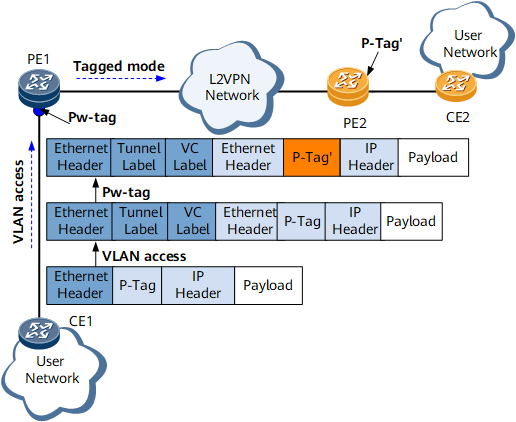(Optional) Configuring a PW-tag Action
This section describes how to configure a PW-tag action so that a PE changes the P-Tag of packets to be forwarded over a PW in tagged mode to ensure normal communication with non-Huawei devices on an L2VPN network.
Context
On the network shown in Figure 1, CE1 and CE2 are connected to the L2VPN network through PE sub-interfaces, PE1 and CE1 are Huawei devices, and PE2 and CE2 are non-Huawei devices.
When a PE transmits multiple services over one PW, the PE adds different P-Tags to packets of different services to isolate the packets on the L2VPN network. When the packets reach the sub-interfaces of another PE on the other end of the PW, each sub-interface accepts only those packets carrying the same P-Tag as that specified on the sub-interface.
However, because the P-Tags on PE1 and PE2 may be different, PE1 cannot communicate with PE2, and users from user networks connected to CE1 and CE2 cannot communicate with each other.
To address the problem, configure a PW-tag action on the user-side sub-interface of PE1. The PE1 sub-interface changes the P-Tag of packets to that on PE2 before forwarding the packets over the PW. This allows PE1 to communicate with PE2.
Table 1 provides the default P-Tag values and the P-Tag values after the PW-tag action.
Sub-Interface Type |
Default P-Tag Value |
P-Tag Value After the PW-Tag Action |
|
|---|---|---|---|
Dot1q sub-interface |
VLAN ID in a packet |
New VLAN ID |
|
Dot1q VLAN tag termination sub-interface |
|||
QinQ VLAN tag termination sub-interface |
Outer VLAN ID in a packet |
||
QinQ stacking sub-interface |
Minimum VLAN ID in the VLAN ID range specified on the sub-interface |
||
QinQ mapping sub-interface |
Fixed VLAN ID in the system |
||
Procedure
- Run system-view
The system view is displayed.
- Run interface interface-type interface-number.subinterface-number
The view of a user-side sub-interface on a PE is displayed.
- Run pw-tag { vlan-id | inner-vlan | outer-vlan } [ 8021p { 8021p-value | inner-vlan | outer-vlan } ]
A PW-tag action is configured so that the sub-interface changes the P-Tag of packets before forwarding the packets over the PW in tagged mode.
- Run commit
The configuration is committed.
